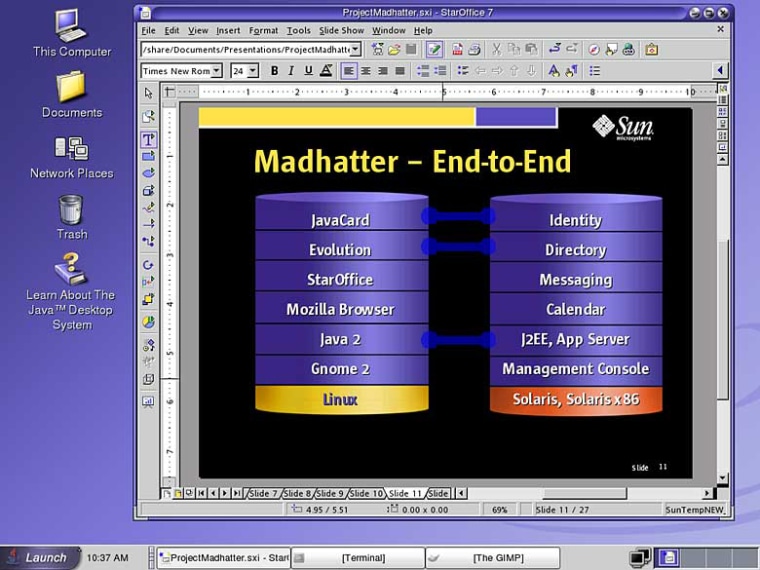When it comes to operating systems, Microsoft, IBM and Apple aren’t the only mega-companies with all the knowledge. Sun, with its Solaris OS, has years of expertise with Unix-based operating systems. But in the 21st century, Sun has decided to add Linux to the mix. It includes full support for the company's Java system – plus a suite of office software – in one package.
It’s called Sun Java Desktop System, or JDS for short. Like Solaris, it’s designed for offices and businesses more than for extensive home use. But, Sun has just announced that hardware manufacturer Microtel will now make you a computer with the JDS operating system inside for $298-698 depending on the configuration. They're for sale on Walmart.com.
JDS 1.0 is based on a well-established and popular flavor of Linux called SuSE. Sun, in its own literature has high hopes for the new offering:
“With the Sun Java Desktop System, Sun has delivered the first viable Microsoft Windows alternative. The Java Desktop System is a more affordable, secure desktop that is designed to thrive in a Windows-centric world. It’s also the only environment with fully integrated Java technology, making this “out-of-the-box” desktop ready to run thousands of Java technology-based applications with a consistent look and feel.
The Java Desktop System is a comprehensive, secure, highly-affordable enterprise desktop solution that consists of a fully integrated client environment based on open source components and industry standards, including a GNOME desktop environment, StarOffice Office Productivity Suite, Mozilla browser, Evolution mail and calendar, Java 2 Platform, Standard Edition (J2SE platform) and a Linux operating system.”
With that type of bragging I couldn’t resist. I’ve been playing with JDS for a few weeks now – and have some definite thoughts about where it stands among the modern-day operating systems.
Using JDS
Installation was very simple. Using the CDs in the JDS album (OS, programs and source code disks are provided) I installed JDS on three machines, two desktops and one laptop. Installation was pretty quick and easy. That’s the good news.
If you intend to use JDS on a desktop computer the SuSE installation process is nearly perfect (only had to adjust the audio). All the hardware in the two desktop boxes was installed and configured properly. Surfing the Web, creating office documents, email and just about everything else that a basic office worker might need worked first time – every time.
The laptop installation was another story. It seems the version of SuSE that was used is old – and getting older all the time. And that proved to be problematic for some simple items like a WiFi card. It would not install the first time – or any time. I even had a number of Sun engineers trying to help. Nothing worked.
Someone hinted that the version of SuSE Sun used had some ancient hardware drivers – and that everything should be better in JDS version 2.0. Two problems with that scenario: first, since JDS was released, SuSE Linux was purchased by Novell. I'm not sure Sun will be able to persuade Novell to help. Second, I’ve just read a review of the brand-new SuSE 9.1 beta OS –- and in addition to all the great new features the writer complained that his WiFi card wouldn’t install. That doesn’t bode well for JDS or SuSE – especially when you consider that other Linux flavors, such as Linspire (the former Lindows) has no problem with installing my WiFi cards, or anything else I’ve thrown at it.
All that aside, as a desktop computer operating system Sun’s JDS is really nice to use. The GNOME desktop is simple and easy to master. The OS was smooth and quick on all my machines – including the 4-year old box with a Celeron processor and 128MB of memory – up to my 3.0GHz Pentium 4 with 512MB.
Surfing the Web with Mozilla was a breeze, Evolution e-mail software is easy to figure out and the inclusion of the latest version of Sun’s StarOffice software suite (a $75 option with Linspire/Lindows) makes this OS a real option for businesses and individual users alike.
Sun is pricing JDS very competitively. It’s $100 per user (with group discounts for enterprise customers.) Not bad when you consider that the office software is included. And, as a special promotion, individuals can purchase JDS at half price - $50 – until June 2 on the Sun Website.
And finally, looking ahead to JDS 2.0 and 3.0, Sun is proudly showing a future 3-D version – with a very, very cool looking desktop. The next versions of JDS could be extremely interesting.
